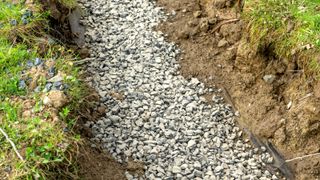Installing a French drain in six easy to follow steps
Knowing how to build a French drain is a DIY project that will remove unwanted water and reduce the risk of water damage. Here we tell you what you need to know

If flooding is a problem around your home, installing a French drain is a cost effective DIY solution that will help protect your property. You don’t need to be a drainage expert to build a French drain, just a few tools and some essential know-how which you can find in this guide.
Sowhat is a French drain? It is a simple form of land drainage that involves a shallow ditch that runs away from the problem area into a suitable drainage area. The ditch is lined with a membrane and filled with aggregate and a pipe with holes. The water drains through the aggregate, and when it rises above the level of the pipe the water is carried away so it no longer reaches the surface. Problem solved. But before you start make sure that there are no undergrounds pipes or cables in the location you are going to dig.
Here we tell what tools, materials and techniques you’ll need to know so you can install your own French drain.
Installing a french drain: the tools you’ll need
- A spade or mini digger
- Wheelbarrow
- Perforated pipe
- Geotextile membrane
- Aggregate
How to install a French drain
Plan ahead and decide where your French drain is going to start and make sure that you have all the tools ready to go.
1.Dig trench
Choose where you are going to start digging. Typically your trench will need to be around 30cm deep, but this can be deeper if needed. Make it 30-40cm wide at the bottom depending on the size of the pipe you are using. You will need enough room to put a decent amount of aggregate.
The walls of the trench need to be sloped to help drainage and the trench will need a slight slope from start to finish – around 10-20mm for every three metres – so the water will naturally drain.
The digging can be done by hand, but it's hard work. If you have a large length of pipe to lay, hire a mini digger and ensure you have an area to store any unused earth.
2. Lay fabric membrane
The trench needs to be lined with a water-permeable landscape membrane like thisSpudulica Geotextile Membrane from Amazon. This will keep the soil separated from the aggregate and help prevent the drain getting blocked. Make sure that it goes over both edges by around 300mm.
3. Add aggregate
The bottom of the trench needs to be filled with a layer of aggregate on which to lay the pipe. A 10-20mm sized aggregate like this从百安居simpa 20毫米自然豆砾石will do the job. Use anaggregate calculator给你一个粗略的你需要多少。费尔l the bottom of the trench to around a third of the depth of the trench.
4. Add pipe
Now lay your perforated land drain pipe – 100mm pipe is a good option – on top of the recently laid aggregate. The perforations in the pipe need to be face down, so when the water rises it will seep into the pipe straight away.
Check your local hardware store to see if they sell the pipe. If not, search online for 100mm perforated land drain pipe. Drain pipe commonly comes in 25m lengths. If you need more you will need to purchase connectors as well.
5. Add more aggregate
With the pipe in place you now need to cover the pipe with more aggregate, around 10 cm from the top. Now cover the aggregate with the remaining fabric that is left either side of the trench you have left over. This will stop dirt and debris getting into the drain and clogging it up.
6. Finish up
When finished there are a few options to hide the drain. You can cover the membrane with the same aggregate you used previously and take it up to up to the level of the surrounding area. This is a smart – and cheaper – option if you have plenty of aggregate left over.
Alternatively, you can finish off with decorative aggregate to blend in with yourmodern garden ideas. Another option is to cover with sand or soil and lay turf or grass seed to disguise the drain. But mark where the drain starts in case you need to dig around the area.
Installing a French drain FAQs
Will a French drain work without a slope?
No. A French drain uses gravity to ensure that water flows down the pipe to its destination. You will need a slope of at least one percent along the entire length of the pipe laid. This translates roughly to around 10-20mm for every three metres of pipe.
If there isn’t a slope the water will struggle to drain away, negating the purpose of installing the drain.
What size pipe do I need to use?
This will depend on how much water you are looking to get rid of. But typically for the area around your home a 60mm, 80mm or 100mm pipe will be adequate.
It's not essential but think about installing an access point such as a bottle gully at the start of the French drain so you get access to clean when needed.
Get the Homebuilding & Renovating Newsletter
Bring your dream home to life with expert advice, how-to guides and design inspiration, direct to your inbox.
Steve is Homebuilding & Renovating's DIY content editor, and has been a writer and editor for two decades. He is an avid DIYer with over 20 years of experience in transforming and renovating homes. He specialises in painting and decorating, but has strong all-round building skills, having previously worked in the industry for 10 years.

